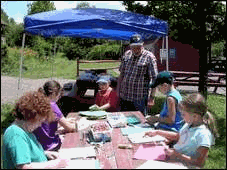Nationwide Program – Neighborhood Environmental Report Your Home Health Status
Nationwide Program – The Keystone Clean Water Team is in pre-launch for a new USA program to help homeowners. The program helps you to identify the existing and historic environmental hazards in your community. We are working with a national environmental database search company to offer a report to help you understand your home’s or your future homes environmental health status within a community. We are doing this by taking a snapshot of the current and historic environmental concerns and hazards in the community and a review of select criminal activity. This program has been lauched – order a Neighboorhood Hazard Reports.
The program, Neighborhood Environmental Report™, offers a search of over 1,400 databases and millions of records of potential land and groundwater contamination within 1 mile radius of the entered address. The report includes a search for concerns that might be dangerous to a homeowner’s family or investment such as nearby leaking underground oil tanks, leaky underground fuel tanks (LUSTs), leaky above ground tanks (LASTs), CDC Health Assessment Database, landfills, hazardous waste sites, DOD facilities, gas and radiological sources, National Wetland Mapping, Flooding mapping data, drug houses, and clandestine drug labs.
Healthy Communities = Healthy Kids and Families
Some of the most toxic and/or costly hazards exists outside of your home. These contaminants can enter your home through direct human or animal contract or vapor intrusion into your home through the air, soil, or groundwater. These hazards pose a threat to you and your family’s health and the value of your property. Every report includes detailed information about what has been searched and identified as well as contact information for all governmental and private organizations cited in the databases.
The benefits of this report:
1. Help existing homeowners understand the hazards in their communities.
2. Aid future homeowners quickly learn about the historic hazards and concerns to conduct prior water quality, soils, or environmental testing and get the proper inspections.
3. Aid real estate professionals, investors, and appraisers evaluate the value of a home or residential property.
4. If you are selling your home, what a great way to introduce your home and surrounding community to any potential buyers, and as a home buyer, the Neighborhood Environmental Report helps provide peace of mind for you and your family.
5. For environmental groups, this is a great way to educate and inform your community about existing environmental hazards, develop local targeted sub-watershed monitoring programs, and educate children about their communities. In some cases a larger search area is needed.
6. Home inspectors, environmental laboratories, and other may find the reports useful, but in many cases some additional review or interpretation will be needed to select the appropriate testing parameters, inspections, and monitoring.
(Example Report Dallas Pennsylvania)
We ran this report for a small business owner that was looking to purchase a residential property in Shavertown, PA. The property was going to be purchased for cash. We completed the search and search identified a specific potential problem with a past but active leak at a gasoline station. This lead the buyer to ask for more information. When the right questions were asked, it was determined that there may be some environmental hazards that could impact the value of the property. In addition, the preliminary search suggested that the property could be located in a floodplain. The quote from the buyer – “The preliminary information and educational materials allowed me to better understand my risk and allow me to find a new property in a timely manner and save over $ 200,000.00” (GW, Shavertown, PA, 2015).
During the period from 2010 to 2011 – the following are the states with the most “Meth Lab” busts: Missouri, Tennessee , Indiana , Kentucky, Oklahoma, Illinois, Iowa, Michigan, North Carolina, and South Carolina.
We are in pre-launch on this service. During pre-launch we are offering to complete compile this report for a fee of only $ 55.00. After pre-launch and website design, we think the final cost will be $ 75 and up. Neighboorhood Hazard Reports
2. Contact Mr. Brian Oram at the Keystone Clean Water Team (KCWT) at cleanwater@carbonwaters.org and provide the mailing address for the property, your contact information, email address, and phone number. We can provide this service for the USA. For some areas, we may need more information.
Terms and Conditions
1. Reports do not meet the terms and conditions of an environmental audit for real estate translations.
2. Reports can not be resold and the copyright will be maintained by the Keystone Clean Water Team.
3. Any analyses, estimates, ratings or risk codes provided in this Report are provided for illustrative purposes only, and are not intended to provide, nor should they be interpreted as providing any facts regarding, or prediction or forecast of, any environmental risk for any property. Only a Phase I Environmental Site Assessment performed by an environmental professional can provide information regarding the environmental risk for any property. This Report is not a replacement for a home inspection. This Report does not provide information pertaining to the interior of the target property such as, but not limited to: mold, asbestos, lead, radon or other issues. Additionally, the information provided in this Report is not to be construed as legal advice.
4. This report contains certain information described herein pertaining solely to the exterior of the target property, which information was obtained from a variety of public and other sources reasonably available to the database search company. The company. does not produce, maintain or verify the information contained in these sources; and assumes, without independent investigation, that the information in such sources is accurate and complete.
Everything we do began with an idea.
We have offered “Free” Assistance to this effort, but if you are a private well owner that needs assistance we are happy to help.
We realize your time is precious and the world is hectic. KCWT’s volunteers do only what they’re comfortable. It can be a little or a lot. Get YOUR WATER Tested – Discounted Screening Tests, posting articles on social media, or assisting with a local event !
For more information, please go to KCWT’s About Page or contact us. Follow us on Twitter
Keystone Clean Water Team is a 501(c)(3) IRS approved nonprofit, volunteer organization and your donation is tax deductible to the extent allowed by law. Unsolicited donations are appreciated (Helps us complete our mission), but we also do local educational workshops and local cellphone/small electronic recycling programs. If you would like to set up a program to help recycle cellphones at an event, business, or other organization. Through our program we can recycle cell phones, iPods, game systems, and small digital cameras. If your interested, please contact us. Our new PSAs.
Help the Organization and Get Your Water Tested or Order the Private Well Owner Guide (proceeds benefit This Organization). Water Science Basics!
Wastewater Used to Map Illegal Drug Use
Environment News Service
CORVALLIS, Oregon, July 15, 2009 (ENS) – For the first time, patterns of illegal drug use across a state have been mapped using a method of sampling municipal wastewater before it is treated.
Applying analytical methods developed at Oregon State University, researchers from OSU, the University of Washington, and McGill University collected single-day samples from 96 municipalities across Oregon, representing 65 percent of the state’s population.
They tested the samples for evidence of methamphetamine, cocaine, and MDMA, commonly called ecstasy.
Municipal water treatment facilities across Oregon volunteered for the study to help further the development of this methodology as a proactive tool for health officials.
Their findings provide a snapshot of drug excretion that can be used to better understand patterns of drug use in multiple municipalities over time.
The study, published this week in the journal “Addiction,” reports a demonstration of this method conducted by UW drug epidemiologist Caleb Banta-Green, OSU chemist Jennifer Field, OSU toxicologist Daniel Sudakin, McGill spatial epidemiologist Luc de Montigny and others.
“This work is the first to demonstrate the use of wastewater samples for spatial analyses, a relatively simple and cost-effective approach to measuring community drug use,” said lead author Banta-Green.
Meth user (Photo courtesy Eyes of the World Media Group)
“Current measures of the true prevalence of drug use are severely limited both by cost and methodological issues,” he said. “We believe these data have great utility as a population measure of drug use and provide further evidence of the validity of this methodology.”
“Municipalities across the state generously volunteered to help us test our methods by collecting samples more or less simultaneously, providing us with 24-hour composite influent samples from one day – March 4, 2008,” said Field, who led the laboratory analyses of the samples.
Lab tests of the samples showed that the index loads of a cocaine metabolite were significantly higher in urban areas and below the level of detection in some rural areas.
Methamphetamine was present in all municipalities, rural and urban.
Ecstacy was at quantifiable levels in less than half of the communities, with a significant trend toward higher index loads in more urban areas.
The researchers said their study validates wastewater drug testing methodology that could serve as a tool for public health officials to identify patterns of drug abuse across multiple municipalities over time.
“We believe this methodology can dramatically improve measurement of the true level and distribution of a range of illicit drugs,” said Banta-Green. “By measuring a community’s drug index load, public health officials will have information applicable to a much larger proportion of the total population than existing measures can provide.”
The research team recognized that the data used for this study are inadequate as a complete measure of drug excretion for a community or entire state. The team looked at a single day, mid-week sample, for instance. Results might be altered depending on the day or time of year the sample was gathered.
Currently, Field and Banta-Green are working on a project funded by the National Institutes of Health to determine the best method for collecting data in order to get a reliable annual estimate of drug excretion for a community.
NKeystone Clean Water Team Available – Hazards in Community and Drug Labs.


